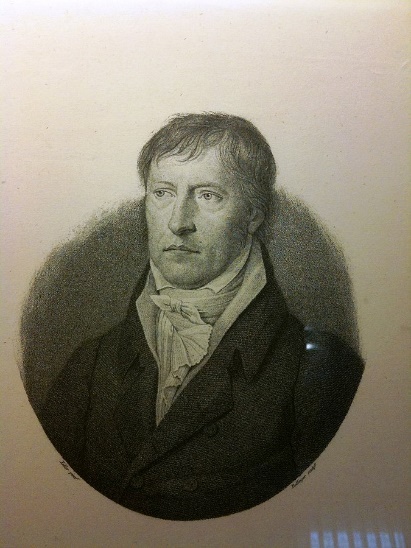9.5 What Is the Relationship Between Art and History? – Hegel
LEARNING OBJECTIVES
By the end of this section you will discover:
- How Kant’s successor G.W.F. Hegel introduced the idea of a telos or purpose in the development of the human passion for beauty.
- How he saw our desire for beauty as an expression of the Absolute Spirit as it strove throughout history for freedom and fulfillment.
- How he saw the arts as progressing through three phases—the symbolic, the classical, and the romantic—as the Absolute Spirit and human minds progressed from simple to complex forms of self-realization.
- How the final stage, the Romantic, should be understood as the completion of this process and the culmination of the artistic expression of humanity.
Why do we humans create works of art? Is it merely a form of entertainment, or do the arts, especially the fine arts, represent something larger, something more important? We know that art forms have changed and evolved over time, but have they been evolving “toward” something? Is there a “telos”—a goal, a purpose, an end—to the human endeavor to create works of beauty?

Georg Wilhelm Friedrich Hegel (1770-1831) was a prominent German philosopher who lived during the late 18th and early 19th centuries. Born in Stuttgart, Germany, Hegel studied theology and philosophy at the Tübingen seminary in his youth and was a professor and chair of philosophy at universities in Jena, Heidelberg, and Berlin during his career. His major works include “The Phenomenology of Spirit” (1807), “Science of Logic” (1812-1816), and the “Encyclopedia of the Philosophical Sciences” (1817). His Lectures on Aesthetics is a compilation of notes from university lectures on aesthetics given by Hegel in Heidelberg in 1818 and in Berlin in 1820/21, 1823, 1826 and 1828/29. These were compiled after his death by a student.
To approach Hegel’s aesthetics we must first understand a bit about his notion of Absolute Spirit and its relation to history. The Absolute Spirit is the fundamental universal idea that encompasses all of reality. It is the “divine subjective” or “world mind.” This Spirit is evolving. It develops progressively toward self-awareness and true freedom through the dialectical movement of history, embodied in human culture and societal institutions as well as in individual consciousness. This Spirit is both transcendent (abstract, incomprehensible) and immanent (embodied, present in the concrete world). It is the underlying unity across all oppositions and differences, the totality of existence. For Hegel, the phenomenal world is the outward manifestation of Absolute Spirit expressing itself in space and time.
All human philosophical ideas and cultural expressions of freedom are approximations of the truth ultimately found in the totality of the Absolute Spirit. As Spirit moves progressively toward greater and greater freedom, the arts, as forms of free expression par excellence, reflect humankind’s movement toward greater and greater liberty. Hegel argues that history has taken us through three main phases of conscious development:
- Symbolic Art: The earliest phase in which artworks were symbolic representations that did not closely resemble the physical world. Example – Ancient Egyptian and Mesopotamian art.
- Classical Art: Art from Ancient Greece and Rome when forms became more realistic and balanced. There was a focus on harmony, proportion, and beauty.
- Romantic Art: Began in the Middle Ages and includes modern art. Artworks began to emphasize subjectivity, emotion, and complexity rather than objective beauty and clarity. There is more attention to inner states of being.
It is in this final stage that Absolute Spirit finds its most complete fulfillment. It marked the culmination of art’s historical development. After reaching the heights of classical Greek art, Hegel saw the Romantic period (approximately 1800 to 1850 A.D.) as a time when art became fully self-aware in reflecting Absolute Spirit.

The Romantics emphasized individuality, subjectivity, and emotional expression in their art. Hegel appreciated this focus on the subjective experience as it contrasted with the more rigid, formal structures of previous artistic movements. Hegel also saw in Romantic art a celebration of freedom and imagination. The Romantics explored themes of nature, the supernatural, and the unknown, which resonated with Hegel’s idea of art as a medium to express the inner spirit and imagination. He believed that during the Romantic period, art had the potential to reunite with religion. He saw art as a means to explore and express spiritual and divine elements, similar to how religion often does. He also saw in it a close connection between philosophy and art. He found resonance in the Romantic artists’ exploration of philosophical themes in their works.
Thus, for Hegel, Romantic art represented the long historical process of art discovering its purpose – that to give expression to inward subjective spirit rather than replicate outward objective forms. This marked the end of art’s evolution and its highest realization before philosophy took over expressing Absolute Spirit. Art became entirely free in Romanticism.
In conclusion, Hegel believed art allows Absolute Spirit to achieve self-awareness, freedom, and self-expression by using the human creative impulse. The spiritual essence of existence becomes condensed in sensuous artifacts. Ultimately art propels Spirit’s coming to know itself through imaginative human endeavor. Its highest realization comes in romantic art’s unfettered subjectivity reflecting Spirit.
Works Cited:
Georg Wilhelm Friedrich Hegel (1770-1831), https://commons.wikimedia.org/wiki/File:Hegel_042.jpg, CC BY 3.0. Accessed 11 Mar. 2024.
Thomas Luny, A Packet Boat Under Sail in a Breeze off the South Foreland (1780), https://en.wikipedia.org/wiki/British_Marine_Art_%28Romantic_Era%29. Public Domain. Accessed 11 Mar. 2024.

